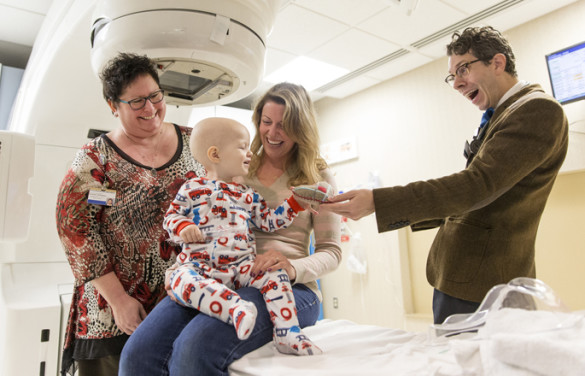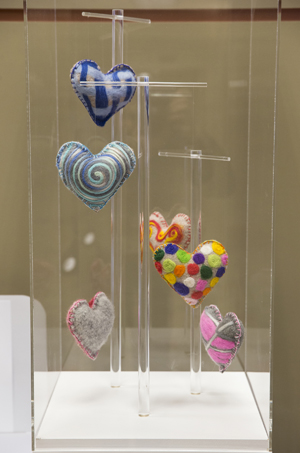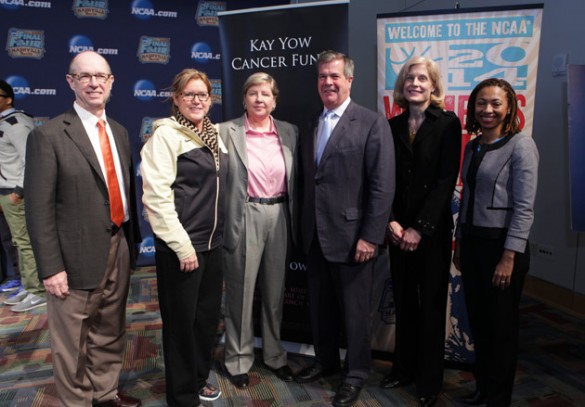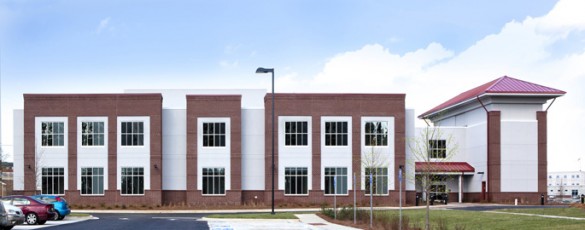
Finn Schafran has always been a happy child, but these days the nearly 2-year-old boy is adjusting to spending part of each day at Vanderbilt-Ingram Cancer Center (VICC), where he receives chemotherapy and radiation for a rare cancer.
Finn’s parents sought treatment when they realized their son was having pain and then developed a bulge in his abdomen. Eventually the Spring Hill, Tennessee, family was referred to Monroe Carell Jr. Children’s Hospital at Vanderbilt, where physicians diagnosed Finn’s cancer as rhabdomyosarcoma, a rare soft-tissue cancer that is growing in his bladder.
“It was my worst nightmare,” recalled Finn’s mother, BrandiLee Schafran. “It was gut-wrenching to me because you don’t want to see your child go through the cancer treatment, but on the other end of it, you know they’re going to be well.”
Recently, VICC clinicians presented Finn and his mother with a little something to help ease the burden — a soft fabric heart for him to hold during visits to the hospital. These small stuffed hearts made from felted wool or other fabrics are part of a new “Heart to Hold” initiative designed to provide comfort to cancer patients receiving radiation and their family members.
The Heart to Hold project was suggested by Finn’s doctor, Mark Stavas, M.D., assistant professor of Radiation/Oncology and director of Supportive Radiation Services, who had received a similar fabric heart years earlier from the family of a cancer patient who died.
“It was a young gentleman who had metastatic colon cancer and his wife was in her third trimester of pregnancy at the time. He died shortly after the child was born.”
Stavas said the case was challenging because the young man was unable to speak about his grief at the end. But during treatments, he would hold a heart that his wife had sewn.
“After his death his wife gave me the heart that he had held as a gift in gratitude. I kept this heart for a year and a half before I started my practice. Every day I see what patients go through; transformative moments where there’s nothing you can say to make it better. Sometimes you just have to sit quietly with somebody and hold the space for uncertainty, or maybe give them an object. This idea of transferrable objects, saying ‘I don’t know what this means but I’m here with you no matter what happens,’ and having a symbol for that, is what ultimately brought this idea to fruition,” Stavas said.
VICC supportive oncology nurse practitioner Rachel McDowell, APRN, who crochets, paints and sews in her spare time, started experimenting with needle felting and produced some sample hearts.

“I showed these to Mark and thought it would be awesome to have them on display as a kind of encouragement to other people to make hearts for our patients,” McDowell said.
Stavas commissioned artist friend Christopher Prinz from Omaha, Nebraska, to design an art installation to showcase the hearts. Next to the “Heart to Hold” display case, which now sits in the VICC lobby, visitors can pick up instruction sheets that explain how to make the hearts.
In the meantime, McDowell and Stavas starting giving the fabric hearts to patients, and McDowell has been gratified by the reaction.
“It has an amazing power for the patient. What struck me is that patients would just hold them and grip them and squeeze them, and it was obviously a way to release some of the energy that they were having and also something they could carry with them as a constant reminder that you’re not alone, that someone cares for you,” McDowell said.
Other groups have joined the Heart to Hold initiative, including people from Crockett County, Tennessee, where everyone from school children to community groups mobilized to make hearts in memory of a beloved community activist and VICC patient who recently died from cancer. Some of the children inserted secret messages of support in the hearts they donated.
To date, patients, family members and others have created and donated more than 2,000 fabric hearts to be shared with VICC patients.
The hearts are now being given to patients in the Radiation/On-cology clinic, but if enough hearts are donated the program may expand to other clinics.
BrandiLee Schafran said she may cradle the heart given to little Finn more than he does.
“I think it’s an amazing thing because you know that people are praying for you and you know that you’re in so many people’s thoughts and minds. It gives something tangible…It’s just so amazing that people thought of doing that and wanted to help the patients in any way that they could and give them something so they can know that they’re not alone, and they’re thought of and loved and prayed for.
“It’s just amazing. I’m really touched and so grateful for the amazing staff at Vanderbilt,” Schafran said.
For more details about the Heart to Hold initiative, visit www.H2H-Nashville.com.















